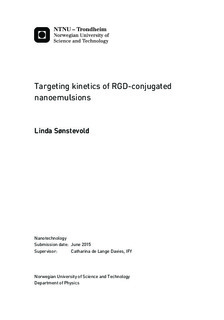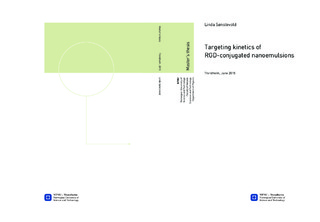| dc.description.abstract | The overall aim of this project was to study targeting kinetics of fluorescently labelled RGD-conjugated nanoemulsions (RGD-NE) to avb3-expressing human umbilical vein endothelial cells, and obtain a better understanding of how kinetics of avb3 internalisation and recycling, affect nanoemulsion (NE) targeting kinetics. An understanding of these kinetics may contribute to obtain more efficient delivery of NE. Flow cytometry and confocal laser scanning microscopy was used for analysis. One part of the project concerned investigation of the credbility of an hypothesis proposed by Hak et al., where in vivo periodicity in NE targeting kinetics was explained by avb3 binding, internalisation and recycling kinetics. In accordance with the hypothesis, saturation binding of surface avb3-integrins by RGD-NE, was found within 2.5 min for concentrations above 0.1 mM. Immunolabelling indicated RGD-NE incubation reduced surface expression of avb3-integrins, when incubated 10 min or longer. The indicated enhancement of avb3 internalisation by RGD-NE binding, is in compliance with Hak et al. s hypothesis, but the time frame and extent of enhanced internalisation is not. Also, from modifications of in vitro experiments performed by Hak et al., results suggest that the time frame or other assumptions regarding the occurence of avb3 internalisation and recycling in the hypothesis, is likely not correct. Together, this indicates that the observed in vivo targeting periodicity is not (only) caused by avb3 kinetics. The other part of the project concerned the establishment of a protocol based on confocal laser scanning microscopy, where the cellular distribution of avb3-integrins and RGD-NE could be monitored during NE incubation. Fixation was tested, but live cell imaging was prioritised in development of the protocol. NE incubation was performed on the microscope and imaged in real-time. To study kinetics of NE internalisation and trafficking to the perinuclear region, cell stainings were tested to detect regions-of-interest for whole cell cytosols and perinuclear regions throughout the time series. Staining with Hoechst 34580 and Calcein AM was found suitable for this. However, in contrast to unstained cells, no NE uptake and cell death was observed with these stainings, most likely due to phototoxicity. Optimisation of the imaging process is therefore needed for usage in intended studies. To monitor avb3 internalisation and recycling kinetics, transfection of a GFP-tagged b3-integrin was tested. The method showed potential, but further studies and optimisation of transfection protocols are necessary before kinetics may be monitored. | |

